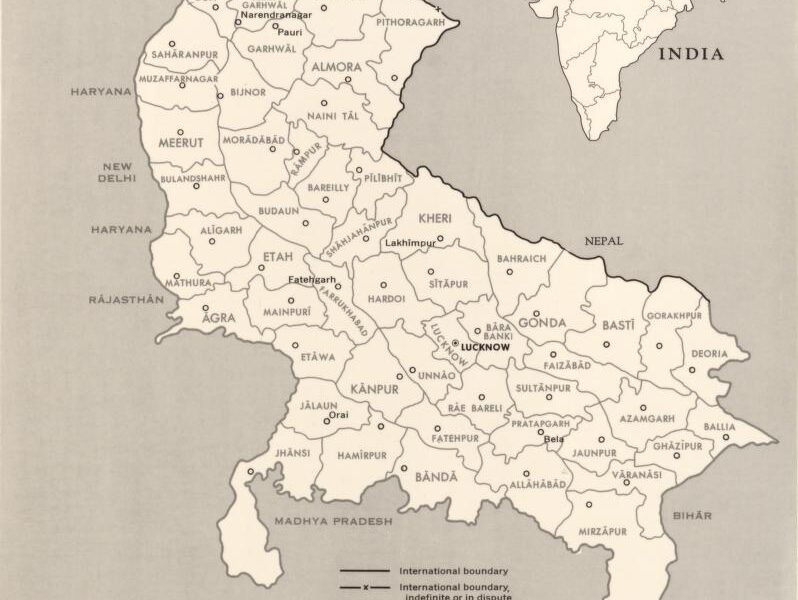India’s the heartland, Uttar Pradesh, is extremely significant in terms of politics, culture, and administratively. In addition to having the largest population in the nation, the state also has one of the most intricate systems of government. Investigating the state’s districts and divisions is necessary to comprehend its administrative structure. It’s important to keep up with the Uttar Pradesh district-by-district list and division knowledge because changes take place all all the time.
Here is a table showing the number of districts and divisions in Uttar Pradesh:
| Particulars | Count |
| Total Districts | 75 (official) + 1 (temporary: Maha Kumbh District in Prayagraj) |
| Total Administrative Divisions | 18 |
Uttar Pradesh Divisions and Their District Count
There are eighteen administrative divisions in Uttar Pradesh. A Divisional Commissioner oversees a collection of districts that make up each division. This regional framework guarantees efficient district coordination, quality service delivery, and government.
| Division Name | No. of Districts | Districts Included |
| Agra | 4 | Agra, Firozabad, Mainpuri, Mathura |
| Aligarh | 4 | Aligarh, Etah, Hathras, Kasganj |
| Ayodhya | 5 | Ambedkar Nagar, Amethi, Barabanki, Ayodhya (Faizabad), Sultanpur |
| Azamgarh | 3 | Azamgarh, Ballia, Mau |
| Bareilly | 4 | Bareilly, Badaun, Pilibhit, Shahjahanpur |
| Basti | 3 | Basti, Sant Kabir Nagar, Siddharthnagar |
| Chitrakoot | 4 | Banda, Chitrakoot, Hamirpur, Mahoba |
| Devipatan | 4 | Bahraich, Balrampur, Gonda, Shravasti |
| Gorakhpur | 4 | Deoria, Gorakhpur, Kushinagar, Maharajganj |
| Jhansi | 3 | Jalaun, Jhansi, Lalitpur |
| Kanpur | 6 | Auraiya, Etawah, Farrukhabad, Kannauj, Kanpur Dehat, Kanpur Nagar |
| Lucknow | 6 | Hardoi, Lakhimpur Kheri, Lucknow, Raebareli, Sitapur, Unnao |
| Meerut | 6 | Baghpat, Bulandshahr, Gautam Buddha Nagar, Ghaziabad, Hapur, Meerut |
| Mirzapur | 3 | Mirzapur, Bhadohi (Sant Ravidas Nagar), Sonbhadra |
| Moradabad | 5 | Amroha, Bijnor, Moradabad, Rampur, Sambhal |
| Prayagraj | 4 | Fatehpur, Kaushambi, Pratapgarh, Prayagraj |
| Saharanpur | 3 | Muzaffarnagar, Saharanpur, Shamli |
| Varanasi | 4 | Chandauli, Ghazipur, Jaunpur, Varanasi |
District List for UP 2025: Detailed and Up-to-Date
The full list of UP 2025 districts, adjusted to reflect the most recent administrative building, is provided below:
Agra, Aligarh, Prayagraj, Ambedkar Nagar, Amethi, Amroha, Auraiya, Azamgarh, Badaun, Baghpat, Bahraich, Ballia, Balrampur, Banda, Barabanki, Bareilly, Basti, Bhadohi, Bijnor, Bulandshahr, Chandauli, Chitrakoot, Deoria, Etah, Etawah, Farrukhabad, Fatehpur, Firozabad, Gautam Buddha Nagar, Ghaziabad, Ghazipur, Gonda, Gorakhpur, Hamirpur, Hapur, Hardoi, Hathras, Jalaun, Jaunpur, Jhansi, Kannauj, Kanpur Dehat, Kanpur Nagar, Kasganj, Kaushambi, Kushinagar, Lakhimpur Kheri, Lalitpur, Lucknow, Maharajganj, Mahoba, Mainpuri, Mathura, Mau, Meerut, Mirzapur, Moradabad, Muzaffarnagar, Pilibhit, Pratapgarh, Raebareli, Rampur, Saharanpur, Sambhal, Sant Kabir Nagar, Shahjahanpur, Shamli, Shravasti, Siddharthnagar, Sitapur, Sonbhadra, Sultanpur, Unnao, Varanasi.
In this list of legislative regions in Uttar Pradesh, each one serves as an important hub for social, economic, and administrative activity.
Uttar Pradesh’s Administrative Framework: A Hierarchical Framework
In Uttar Pradesh, the state government, divisions, districts, tehsils, blocks, and local bodies are all part of a multi-tiered administrative framework.
- State Level: Under the direction of the Governor, the Council of Ministers, and the Chief Minister.
- At the divisional level, a divisional commissioner is in charge.
- District Level: Managed by a Collector or District Magistrate.
- Sub-District Level: Consists of village councils (gram panchayats), blocks, and tehsils.
This tiered approach guarantees governance in every part of the state. It preserves consistent state-wide regulations while enabling authorities to meet specific requirements effectively.
How UP Divisions and Districts Cooperate
For operational effectiveness, cooperation amongst UP districts and subdivisions is essential. Districts are in charge of carrying out government programs locally, while divisions offer supervisory control.
District officials oversee:
- Law and order
- Collection of revenue
- Provision of public services (welfare, education, and health)
- Development of infrastructure
Divisional commissioners in the interim organize:
- Planning across districts
- Management of disasters
- Communications between departments.
- A smooth transition in government from state toward citizen is produced by this approach.
The total quantity of UP districts and their governance
Authorities have designated the Maha Kumbh region of Prayagraj as a temporary district during the event, adding it to Uttar Pradesh’s 75 formal districts as of 2025. The proper and most recent response to the question of how many districts there are in Uttar Pradesh is still 75, even though in some situations the interim district raises the functional count to 76.
To enable efficient governance, Uttar Pradesh’s districts are categorized under a number of divisions. These departments support the state’s governance of infrastructure, education, public services, and law and order. The UP districts and divisions model of administration is defined by the hierarchical structure in which each division is in charge of multiple districts.
Why It Matters: The Value of Understanding Uttar Pradesh’s Districts
Knowing Uttar Pradesh’s districts is more than just academic;
It’s useful information with real-world implications.
- For students and those aspiring to the UPSC/PCS: Understanding the Uttar Pradesh district-by-district list is crucial.
- For Citizens: District jurisdiction determines how to apply for services like as income certificates, ration cards, or voter ID.
- For journalists and NGOs: District-level knowledge is necessary to track policy efficacy, inequality, or development.
Being aware of the number of legislative regions in Uttar Pradesh and their organizational structure improves one’s interaction with the system.
Past, Present, and Future Trends and Changes
The number of districts in Uttar Pradesh has grown throughout time due to pressures from development and population growth. The government is proposing new districts to increase governance and facilitate administrative access.
The government recently separated districts like Shamli and Amethi for improved management. Although it hasn’t created any new municipalities in 2025, policymakers continue to propose splitting major districts like Ghaziabad or Lakhimpur Kheri.
Uttar Pradesh’s Administrative Framework
The state government is in charge of Uttar Pradesh’s regulatory infrastructure. The deputy chief minister is in charge, with the department heads and the Council of Ministers at his side. A Divisional Commissioner administers each division, while a District Magistrate or District Collector is in charge of administration, law enforcement, and order in each district.
This hierarchy governs the operations of multiple departments, including those related to schooling, medical care, rural development, and transportation. In order to carry out government programs like housing, retirement savings, agricultural subsidies, and construction initiatives, the UP districts and divisions are essential.
Uttar Pradesh uses digital portals for data monitoring, grievance redress, and governance in order to guarantee accountability and openness.District-specific portals offer localized services such as property records, caste certificate issuance, and ration card status.
UP’s Total Districts: A Changing Terrain
The government has created new districts in Uttar Pradesh for improved management, such as carving Amethi out of Sultanpur and forming Sambhal from parts of Moradabad. Depending on population growth, geographic demands, and administrative viability, more adjustments might occur in the future.
Even if there are still 75 districts in Uttar Pradesh, the public needs to be aware of any temporary changes, such as the establishment of the Maha Kumbh district in Prayagraj for the handling of large-scale events.
In conclusion
Gaining an understanding of Uttar Pradesh’s districts, divisions list, and administrative structure is crucial to understanding how the state operates. It is evident from the UP 2025 district list and information about the UP divisions and districts that the state’s governance is among the most organized and adaptable in India.
Whether you’re a student, government aspirant, researcher, or just a curious citizen, knowing the Uttar Pradesh district wise list and the total districts in UP helps you stay informed and aware of one of India’s most dynamic states.





